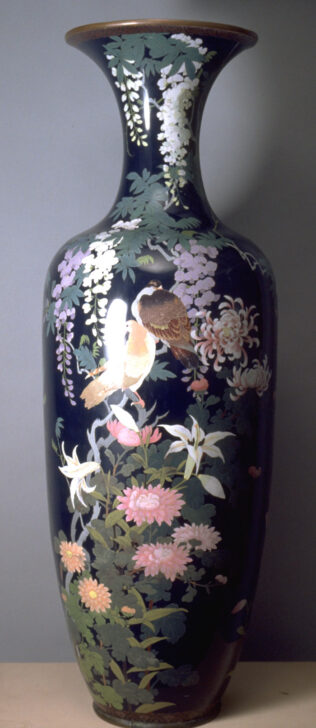Cloisonné Vase
Japanese

Description
President's House object Summary
During the Meiji period (1868-1912), as Japan was increasing its involvement with Western European cultures, cloisonne became one of its major artistic exports. Although the cloisonne process originated in ancient Mycenae and Greece, it was virtually reinvented by Japanese artists in the 1830's and today is considered one of the traditional arts of Japan.
The process of cloisonne involves outlining a design in wires which are attached to an object, tamping enamel pastes into the cells, and firing the object in a kiln. A French term, cloisonne means "divided into cells." The term derives from the words cloisons and emaux which refer to the wire cells and the emamel that fill them. The Japanese word for cloisonne, shippo, refers to the "seven treasures": gold, silver, emerald, coral, agate, crystal, and pearl. The process epitomizes the artists' labor, patience, and painstaking attention to detail.
Japanese artists wishing to build upon the popularity of Chinese-style ceramics in the West used large copper vessels for cloisonne. Usually over 30 cm tall, the vases occassionally had a false Ming-dynasty mark added. Backgrounds are often dark and subtly shaded, and designs are frequently adapted from paintings. Red, Blue, Lilac, and white are common colors. During specific eras, artists used transparent enamels, experimenting with their light-reflecting qualities.
The naturalistic, garden imagery of many cloisonne pieces reflects the importance of the art of gardening and flower arranging within Japanese life. Many cloisonne design present full-face blossoms and depict few flowers in profile. Designs also include flowers of different seasons blossoming together. These strategies exemplify paradoxes between the artifical and the natural, and time immortality. The design on this vase, with its dark blue background and pictured chrysanthemums and wisteria, is characterisic of cloisonne work of the period.
(Laura Zahodne)
Usage Rights:
If you are interested in using an image for a publication, please visit https://umma.umich.edu/request-image/ for more information and to fill out the online Image Rights and Reproductions Request Form.